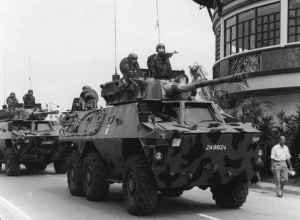| Designation: | SIBMAS |
 |
|---|---|---|
| Manufacturer: | CMI Defence | |
| Product type: | Armoured Vehicles | |
| Name: | Wheeled armoured personnel carrier |
The SIBMAS (6 × 6) wheeled armoured vehicle range was originally designed as a private venture from 1975 by B N Constructions Ferroviaires et Métalliques. A prototype was completed in 1976 and was extensively tested both in Belgium and Malaysia. In many respects the SIBMAS is very similar to the South African (now BAE Systems Land Systems OMC) Ratel (6 × 6) infantry fighting vehicle.
A demonstration vehicle, with improved vision for the driver and a more powerful engine, was completed in mid-1979.
Wherever possible, standard MAN automotive components such as the engine, transmission and axles were used in the design of the SIBMAS.
Late in 1981, Malaysia placed a GBP50 million order with the company for 186 vehicles with first deliveries made in June 1983. Two versions were delivered: AFSV-90: Armoured Fire Support Vehicle with a CMI Defence CM 90 two-person turret and a 90 mm Mk III gun and an OIP LRS-5 fire-control system; 162 were supplied and production was completed in late 1984. ARV: Armoured Recovery Vehicle with front and rear spades, a weight of 20,000 kg, a winch with a capacity of 20,000 kg and a crane with a capacity of 10,500 kg; 24 were supplied and production was completed in mid-1985.
Although CMI took over this vehicle in the mid-1980s, the company is no longer marketing the SIBMAS range of 6 × 6 vehicles and is concentrating on its range of AFV turrets.
Early in 1998, it was revealed that three Malaysian contractors had each overhauled a single example of the SIBMAS (6 × 6) AFV. In the future, it is expected that one of these will be awarded a contract to overhaul part or all of the Malaysian fleet of SIBMAS vehicles. As of late 2007, it is understood that no orders had been placed with any of these contractors. Description
The hull of the SIBMAS is made of all-welded steel and provides the crew with complete protection against 7.62 and 5.56 mm armour-piercing rounds.
The driver sits at the very front of the vehicle and has a single-piece hatch cover over his position that opens to his right, an adjustable seat and an adjustable steering wheel. In front and at both sides of the driver are large bulletproof windscreens providing excellent vision at all times. If required, these can be quickly covered by armoured shutters, which are hinged at the lower part.
The two-person turret is mounted immediately behind the driver and in each side of the hull is a large door that opens forwards.
The troop compartment is to the rear of the turret and the engine at the very rear on the left side. Six of the infantrymen sit back-to-back down the centre of the vehicle with the remaining three in the aisle between the troop compartment and the rear door. One small and three large hatches are provided over the top of the troop compartment and, if required, a remote-controlled machine gun can be pintle-mounted over the aisle. There are spherical firing ports and vision blocks in the troop compartment. These allow the infantry to fire their weapons from within the vehicle with a high level of safety.
The MAN D 2566 MK engine can be removed through the roof of the vehicle in 30 minutes by two men. Quick disconnect couplings are provided for both the power and hydraulic circuits. The cooling system is behind and separated from the engine compartment by a waterproof bulkhead. Power is taken from the engine to the transmission, which is under the floor between the first and second axles, by a propeller shaft. The differentials of the front and rear two axles are lockable and a lockable differential between the two rear axles allows them to be longitudinally locked.
The SIBMAS is a fully amphibious vehicle propelled in the water by its wheels at a speed of 4 km/h. There was also a version with two propellers at the rear of the hull which can be traversed through 360° and give the vehicle a maximum water speed of 11 km/h. The propellers are driven from the Power Take Off (PTO) on the engine. One advantage of the amphibious SIBMAS is that when approaching a river bank the driver can engage first gear and as soon as the front wheels touch the bank maximum tractive effort is available as the propellers are still pushing the vehicle forward. Before entering the water a trim vane is automatically erected at the front of the hull. There are two bilge pumps, each with a maximum capacity of 180 litres per minute, fitted as standard.
The tyres are of the run-flat type. Optional equipment includes passive night vision equipment, a hydraulic winch mounted at the front of the hull with 60 m of cable and a maximum capacity of 8,000 kg (which can be increased to 16,000 kg with snatch blocks), a heater, an air conditioning system and an NBC system.
The SIBMAS could be supplied fitted with a wide variety of armament installations but the CM 90 turret armed with the CMI Defence 90 mm gun, 7.62 mm coaxial machine gun and 7.62 anti-aircraft machine gun is the only combat model to have been produced in production quantities. Variants
Many versions were proposed but apart from the model with a 90 mm CMI Defence turret the only model built in production quantities was the recovery vehicle.
This has a front and rear stabiliser blade, 20,000 kg winch and a 10,500 kg crane.
|
||||||||||||||||||||||||||||||||||||||||||||||||
|
||||||||||||
 |
